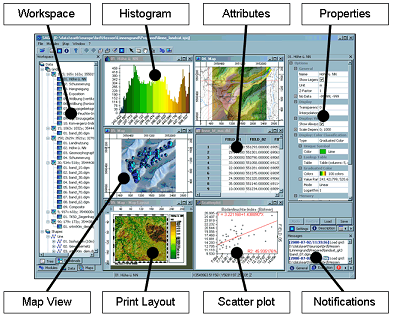Dr. Olaf Conrad

Wissenschaftlicher Mitarbeiter
Arbeitsgruppe Geosystemanalyse
Anschrift
Büro
Kontakt
Schwerpunkte
- Physische Geographie
- GIS u. Geoinformatik
- Geomorphometrie
- Modellierung und Simulation geoökologisch relevanter räumlicher Prozesse
Wissenschaftlicher Werdegang
Seit 2007
- Wissenschaftlicher Assistent am Institut für Geographie, Arbeitsbereich Physische Geographie, der Universität Hamburg
2006-2007
- Technische Universität München, Abteilung für Pflanzenwissenschaften: wissenschaftlicher Angestellter im von der Bayrischen Forschungsstiftung geförderten Projekt GeoSteP - Geoinformationstechnologien für standorteffiziente Pflanzenproduktion
2006
- Promotion zum Dr. rer. nat. an der Georg-August Universtität zu Göttingen
2001-2004
- Georg-August Universität Göttingen, Abteilung Physische Geographie: wissenschaftlicher Mitarbeiter im vom BMBF geförderten Projekt GeoVis - Geographie und Visualisierung
2005-2006
- SAGA User Group e.V., Göttingen: Pflege und Ausbau von SAGA - System für Automatisierte Geowissenschaftliche Analysen
1998-2000
- Geoinformationsdienst GmbH, Rosdorf: Entwicklung eines produktionsorientierten landwirtschaftlichen Rauminformationssystems (POLARIS)
1994-1995
- Auslandsaufenthalt: Studium der Geographie am Trinity College Dublin
1990-1998
- Studium der Geographie (Diplom) an der Georg-August Universität Göttingen mit den Nebenfächern Bodenkunde, Botanik, Geologie
1987-1990
- Studium der Physik (Diplom) an der Technischen Universität Hannover
SAGA GIS

Vorstandsmitglied und Softwareentwickler im SAGA-Projekt, welches seit 2007 am Institut für Geographie der Universität Hamburg beheimatet ist.
Weitere Informationen finden Sie auf der SAGA-Homepage
Publikationen
Wendland, S., Hankers, B., Bock, M., Böhner, J., Squar, J., Lembrich, D. & Conrad, O. (2023): Ein Simulationsmodell zur Erfassung von Abflussrisiken in der Landwirtschaft. – Informatik Spektrum, https://doi.org/10.1007/s00287-023-01522-2.
Wehberg, J., Kilian, M., Conrad, O. & Böhner, J. (2020): Die digitale Jagd auf den Borkenkäfer. AFZ-DerWald 18/2020: 29-31.
Karger, D. N., Kessler, M., Conrad, O., Weigelt, P., Kreft, H., König, C., & Zimmermann, N. E. (2019): Why tree lines are lower on islands-Climatic and biogeographic effects hold the answer. Global Ecology and Biogeography, 28(6), 839-850.
Jahan, R., Schickhoff, U., Böhner, J., & Conrad, O. (2018). Quantification of Geodiversity of Sikkim (India) and Its Implications for Conservation and Disaster Risk Reduction Research. In Climate Change, Extreme Events and Disaster Risk Reduction (pp. 279-294). Springer, Cham.
Bock, M., Conrad, O., Günther, A., Gehrt, E., Baritz, R., Böhner, J. (2017). SaLEM (v1.0) – A Soil and Landscape Evolution Model for simulation of regolith depth in periglacial environments. Geosci. Model Dev. Discuss., https://doi.org/10.5194/gmd-2017-218, in review.
Bechtel, B., Demuzere, M., Sismanidis, P., Fenner, D., Brousse, O., Beck, C., Van Coillie, F., Conrad, O., Keramitsoglou, I., Middel, A., Mills, G., Niyogi, D., Otto, M., See, L. & Verdonck, M.-L. (2017). Quality of Crowdsourced Data on Urban Morphology—The Human Influence Experiment (HUMINEX). Urban Science, 1(2), 15.
Bechtel, B., Conrad, O., Tamminga, M., Verdonck, M. L., Van Coillie, F., Tuia, D., ... & Xu, Y. (2017). Beyond the urban mask. In Urban Remote Sensing Event (JURSE), 2017 Joint (pp. 1-4). IEEE.
Karger, D.N., Conrad, O., Böhner, J., Kawohl, T., Kreft, H., Soria-Auza, R.W., Zimmermann, N., Linder,H.P. & Kessler, M. (2016): Climatologies at high resolution for the Earth land surface areas. Scientific Data 4, 170122.
Weinzierl, T., Wehberg, J., Böhner, J. & Conrad, O. (2016): Spatial Assessment of Land Degradation Risk for the Okavango River Catchment, Southern Africa. – Land Degradation & Development 27 (2): 281-294, doi:10.1002/ldr.2426.
Bechtel, B., Alexander, P., Böhner, J., Ching, J., Conrad, O., Feddema, J., Mills, G., See, L. & Stewart, L. (2015): Mapping local climate zones for a worldwide database of form and function of cities. – ISPRS Int. J. Geo-Inf. 4 (1): 199-219, doi:10.3390/ijgi4010199.
Conrad, O., Bechtel, B., Bock, M., Dietrich, H., Fischer, E., Gerlitz, L., Wehberg, J., Wichmann, V., and Böhner, J. (2015): System for Automated Geoscientific Analyses (SAGA) v. 2.1.4. – Geosci. Model Dev., 8, 1991-2007, doi:10.5194/gmd-8-1991-2015.
Gerlitz, L., Conrad, O., Thomas, A. & Böhner, J. (2014): Assessment of Warming Patterns for the Tibetan Plateau and its adjacent Lowlands based on an elevation- and bias corrected ERA-Interim Data Set. – Climate Research 58: 235-246, doi:10.3354/cr01193.
Eckhardt, M., Urhahne, D., Conrad, O. & Harms, U. (2012): How effective is instructional support for learning with computer simulations? Instructional science. Advance online publication. doi: 10.1007/s11251-012-9220-y.
Eckhardt, M., Urhahne, D., Conrad, O. & Harms, U. (2009): Instruktionale Unterstützung beim Lernen mit Computersimulationen im Fach Biologie. In: Harms et al. (Hrsg.), Heterogenität erfassen-individuell fördern im Biologieunterricht. Internationale Tagung der Fachsektion Didaktik der Biologie im VBiO (FDdB) (S. 230-232). Kiel: IPN Kiel.
Olaya, V. & Conrad, O. (2008): Geomorphometry in SAGA. In: Hengl, T. and Reuter, H.I. [Hrsg.]: Geomorphometry: Concepts, Software, Applications. Developments in Soil Science, Elsevier, Bd.33, S.293-308.
Heinrich, R. & Conrad, O. (2008): Diffusion, Flow and Concentration Gradient Simulation with SAGA GIS using Cellular Automata Methods. In: Böhner, J., Blaschke, T. & Montanarella, L. [Hrsg.]: SAGA - Seconds Out. Hamburger Beiträge zur Physischen Geographie und Landschaftsökologie, Bd.19, S.59-70.
Phua, M.-H., Conrad, O., Kamlun, K.U., Fischer, M. & Böhner, J. (2008): Multitemporal Fragmentation Analysis of Peat Swamp Forest in the Klias Peninsula, Sabah, Malaysia using GIS and Remote Sensing Techniques. In: Böhner, J., Blaschke, T. & Montanarella, L. [Hrsg.]: SAGA - Seconds Out. Hamburger Beiträge zur Physischen Geographie und Landschaftsökologie, Bd.19, S.81-90.
Bock, M., Böhner, J., Conrad, O., Köthe, R. & Ringeler, A. (2007): Methods for creating Functional Soil Databases and applying Digital Soil Mapping with SAGA GIS. In: Hengl, T., Panagos, P., Jones, A. & Toth, G. [Hrsg.] 2007. Status and prospect of soil information in south-eastern Europe: soil databases, projects and applications. EUR 22646 EN Scientific and Technical Research series, Office for Official Publications of the European Communities, Luxemburg, S.149-162. [PDF]
Conrad, O. (2007): SAGA - Entwurf, Funktionsumfang und Anwendung eines Systems für Automatisierte Geowissenschaftliche Analysen. electronic doctoral dissertation, University of Göttingen. [PDF]
Conrad, O., Krüger, J.P., Bock, M. & Gerold, G. (2006): Soil Degradation Risk Assessment Integrating Terrain Analysis and Soil Spatial Prediction Methods. Proceedings of the International Conference "Soil and Desertification - Integrated Research for the Sustainable Management of Soils in Drylands", 5-6 May 2006, Hamburg, Germany. Internet-Publication edited by the Coordination of Desert*Net Germany.
Conrad, O. (2006): SAGA - Program Structure and Current State of Implementation. in: Böhner, J., McCloy, K.R. & Strobl, J. [Hrsg.]: SAGA - Analysis and Modelling Applications. Göttinger Geographische Abhandlungen, Bd.115, S.39-5.
Conrad, O. (2005): Digitale Reliefanalyse in der multimedialen Lehre. Arbeitsberichte des Geographischen Instituts der Humboldt-Universität zu Berlin, Bd.109, S.37-47.
Böhner, J., Schäfer, W., Conrad, O., Gross, J. & Ringeler, A. (2003): The WEELS Model: Methods, Results and Limitations. Catena, Bd. 52, S. 289-308.
Böhner, J., Köthe, R. Conrad, O., Gross, J., Ringeler, A. & Selige, T. (2002): Soil Regionalisation by Means of Terrain Analysis and Process Parameterisation. In: Micheli, E., Nachtergaele, F. & Montanarella, L. [Hrsg.]: Soil Classification 2001. European Soil Bureau, Research Report No.7, EUR 20398 EN, Luxembourg., S.213-222.
Etzrodt, N., Zimmermann, R. & Conrad, O. (2002): Upscaling Water Cycle Parameters Using Geomorphometric Terrain Parameters and Topographic Indices Derived from Interferometric DEM. In: Wilson, A. [Hrsg.]: Proceedings of the 3rd International Symposium on Retrieval of Bio- and Geophysical Parameters from SAR Data for Land Applications, 11-14 September, 2001 in Sheffield, UK. S.251-254.
Selige, T., Ringeler, A., Böhner, J., Conrad, O. & Köthe, R. (2001): Validation of Grid-Based Surface Reconstruction Techniques Applied to Digital Elevation Models Including the Shuttle Radar Topographic Mission. Proceedings of the International Geoscience and Remote Sensing Symposium, IEEE Publication, New York, S.3135-3137.
Projekte
-
Seit 2017
IpsPro: Verbesserte Abschätzung des Risikos für Buchdruckerbefall – Grundlagen für ein Prognosewerkzeug als Bestandteil des integrierten Waldschutzes - Seit 2016
i_SSS (integrated Support System for Sustainability): Scientific cooperation with Bayer CropScience and relevant authorities to develop a GIS based geoecosystemological impact model as a support for resource-efficient and environmentally friendly agricultural production.
- Seit 2010
CHELSA (Climatologies at High resolution for the Earth’s Land Surface Areas): Entwicklung von Methoden für die Erstellung räumlich hochauflösender Klimadatensätze mit globaler Abdeckung.
- 2008-2017
SaLEM (Soil and Landscape Evolution Model): Entwicklung eines Vorhersagemodells zur Regionalisierung periglaziärer Lagen.
- 2013-2016
BCS–DAT (Bayer Crop Science Diagnosis Advisory Tool): Methodenentwicklung und -bereitstellung für ein GIS-Tool für landwirtschaftliche Berater der BCS, zur Ausgabe von Informationen zur Abschätzung von Erosion- und Runoff-Disposition von Ackerschlägen
- 2010-2015
TFO (The Future Okavango): Scientific support for sustainable land and re-source management in the Okavango basin. GIS-based landscape analyses, environmental modelling, and decision support for integrated resource man-agement.
Lehre
Lehrtätigkeit am Geographischen Institut der Univ. Hamburg (seit 2007)
- Seminare (Physische Geographie mit wechselndem thematischen Schwerpunkt):
- Geomorphologie
- Bodengeographie
- Hydrogeographie
Klimageographie u. Klimawandel:
- Vegetationsgeographie u. Ökozonen der Erde
- Landschaftsökologie
Übungen:
- Statistik und Regionalforschung
- GIS Einführung u. Vertiefung
- Fernerkundung
- Geowissenschaftliche Programmierung
- Rasterbasierte Analyse und Modellierung
- Geodatenbanken, Geostatistik und Automatisierung
Exkursionen:
- Nord- und Ostseeküste
- Südniedersächsisches Bergland
- Verschiedene Tagesexkursionen im Raum Hamburg
Vorlesungen:
- Kartographie u. Geoinformationssysteme
